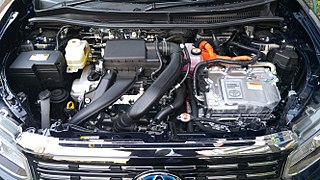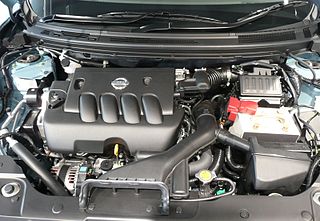
The Volkswagen Golf is a compact car/small family car (C-segment) produced by the German automotive manufacturer Volkswagen since 1974, marketed worldwide across eight generations, in various body configurations and under various nameplates – including as the Volkswagen Rabbit in the United States and Canada, and as the Volkswagen Caribe in Mexico (Mk1).

A diesel–electric transmission, or diesel–electric powertrain, is a transmission system powered by diesel engines for vehicles in road, rail, and marine transport. Diesel–electric transmission is similar to petrol–electric transmission, which is powered by petrol engines.

The Ford Escape is a compact crossover SUV manufactured and marketed by Ford Motor Company since the 2001 model year. The first Ford SUV derived from a car platform, the Escape fell below the Ford Explorer in size; the Escape is currently sized between the Ford EcoSport and Ford Edge. The 2004 Ford Escape Hybrid was the first hybrid-electric vehicle from Ford, and the first hybrid produced as an SUV.

The Infiniti M is a line of mid-size luxury (executive) cars from the Infiniti luxury division of Nissan. From 2013 on it has been marketed as the Infiniti Q70, reflecting the company's new naming scheme.

The QR family of inline-four piston engines by Nissan were introduced in 2000 and range from 2.0 to 2.5 L in displacement. These motors are aluminum, dual overhead camshaft (DOHC), four-valve designs with variable valve timing and optional direct injection. The engine shares much of its architecture with the YD diesel engine.
Hybrid Synergy Drive (HSD), also known as Toyota Hybrid System II, is the brand name of Toyota Motor Corporation for the hybrid car drive train technology used in vehicles with the Toyota and Lexus marques. First introduced on the Prius, the technology is an option on several other Toyota and Lexus vehicles and has been adapted for the electric drive system of the hydrogen-powered Mirai, and for a plug-in hybrid version of the Prius. Previously, Toyota also licensed its HSD technology to Nissan for use in its Nissan Altima Hybrid. Its parts supplier Aisin offers similar hybrid transmissions to other car companies.

The Toyota NZ engine family is a straight-4 piston engine series. The 1NZ series uses aluminum engine blocks and DOHC cylinder heads. It also uses sequential fuel injection, and has 4 valves per cylinder with VVT-i.

The Renault-Nissan MR engine family consists of straight-four 16-valve all-aluminium and water cooled automobile engines with variable valve timing co-developed by Renault and Nissan. Renault calls it the M engine. Other noteworthy features of this engine family include acoustically equal runner lengths and a tumble control valve for the intake manifold, a "silent" timing chain, mirror finished crankshaft and camshaft journals, and offset cylinder placement in an attempt for increased efficiency.

The HR is a family of straight-3 12-valve and straight-4 16-valve automobile engines with continuously variable valve timing, involving development by Nissan and/or Renault, and also Mercedes-Benz in the case of the H5Ht/M282. The designation of H engine is used by Renault, and M28x by Mercedes-Benz, to classify the family. There are three basic specifications of engine involving variations in engine architecture, or all-new architecture, with 72.2 mm (2.84 in), 75.5 mm (2.97 in) and 78 mm (3.07 in) bore diameter.

The Nissan Note is a supermini/subcompact hatchback or a mini MPV manufactured and marketed globally by Nissan. Introduced in 2004, the first-generation Note was primarily marketed in Japan and Europe, and was produced in Japan and the United Kingdom. The second-generation model was sold in other regions, including North America where it was manufactured in Mexico and marketed as the Versa Note, and Thailand, where it serves as one of the B-segment hatchback offered by the brand alongside the smaller March/Micra under the Eco Car tax scheme.

The Nissan Qashqai is a compact crossover SUV (C-segment) designed and produced by the Japanese car manufacturer Nissan since 2006. The first generation of the vehicle was sold as the Nissan Dualis in Japan and Australia, and Qashqai in the rest of the world. The second generation, launched in late-2013 for the 2014 model year, was not sold in Japan and was badged as the Qashqai in all countries it was sold, except in the United States, where it was rebadged as the Nissan Rogue Sport. Since the third and latest generation model launched in 2021, the Qashqai is available with hybrid powertrains.
Hybrid vehicle drivetrains transmit power to the driving wheels for hybrid vehicles. A hybrid vehicle has multiple forms of motive power, and can come in many configurations. For example, a hybrid may receive its energy by burning gasoline, but switch between an electric motor and a combustion engine.

The Nissan Juke is a subcompact crossover SUV (B-segment) produced by the Japanese car manufacturer Nissan since 2010. Debuted as a production vehicle at the 2010 Geneva Motor Show in March, it was introduced to North America at the 2010 New York International Auto Show to be sold for the 2011 model year as the smallest crossover in Nissan's lineup prior to the introduction of Magnite in 2020, it is currently slotted between the smaller Magnite and the larger Kicks.

A range extender is a fuel-based auxiliary power unit (APU) that extends the range of a battery electric vehicle by driving an electric generator that charges the vehicle's battery. This arrangement is known as a series hybrid drivetrain. The most commonly used range extenders are internal combustion engines, but fuel-cells or other engine types can be used.

The BYD Qin is a series of compact and mid-size sedans produced by BYD Auto since 2012. The Qin started out as the plug-in hybrid version of the BYD Surui, and was introduced in the Chinese market in August 2012. Currently, the Qin is available as a plug-in hybrid (PHEV), battery electric vehicle (BEV), and previously an internal combustion engine (ICE) vehicle.

The Nissan Kicks is a subcompact crossover SUV produced by Nissan since 2016. The crossover was initially introduced as a concept car under the same name and was premiered at the 2014 São Paulo International Motor Show. Nissan claimed the concept is inspired by the streets of Brazil.

The Subaru B5-TPH was a concept shooting-brake coupe with a Turbo Parallel Hybrid (TPH) powertrain made by Fuji Heavy Industries (FHI), introduced at the 2005 Tokyo Motor Show.
The Dongfeng Rich is a series of pickup trucks produced by the Dongfeng Nissan joint venture of Chinese auto manufacturer Dongfeng Motor Corporation.

The Suzuki K engine family is a series of automobile engines from Suzuki, introduced in 1994. Displacements range from 0.7 L to 1.5 L. All engines have aluminium cylinder blocks with three or four cylinders in-line. Cylinder heads have two overhead camshafts, driven by chain, and four valves per cylinder. Fuel is gasoline/petrol, metered by multipoint fuel injection or direct injection. Some variants are turbocharged.
The McLaren M630 engine is a 3.0-litre, 120-degree, twin-turbocharged V6 engine, designed and developed for use in the Artura sportscar by McLaren Automotive.
















